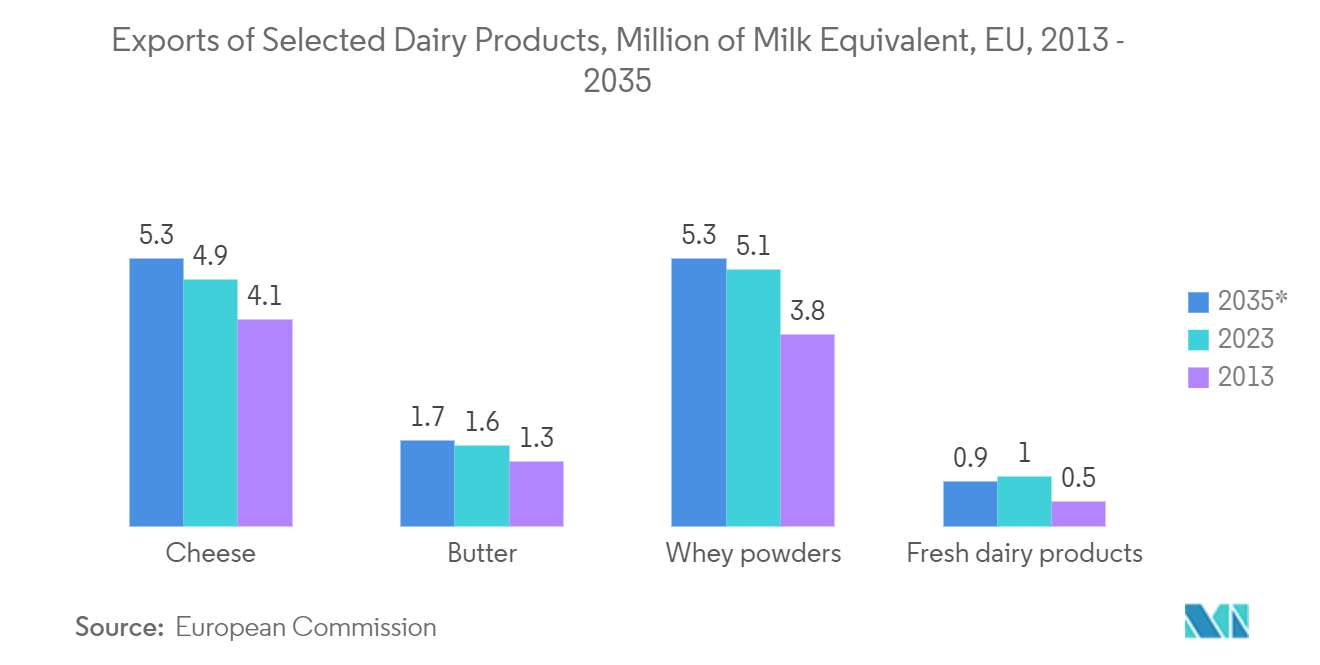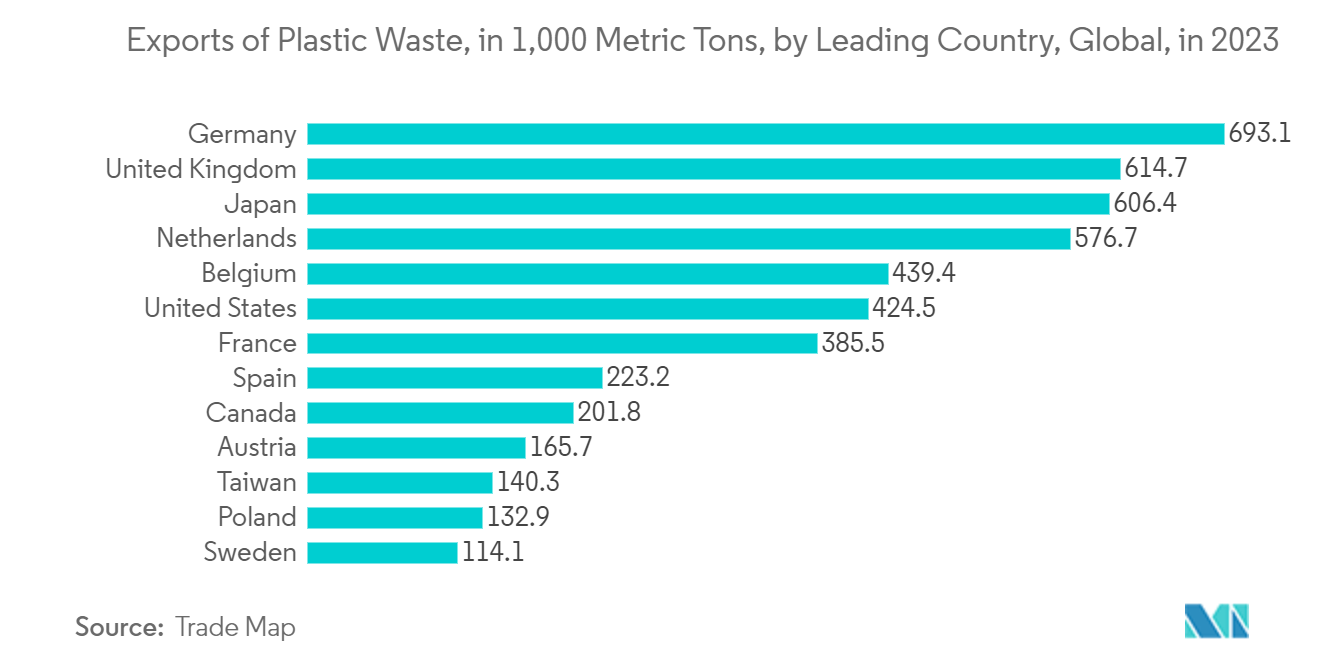Market Trends of Europe Rigid Plastic Packaging Industry
The Food Segment is Expected to Hold a Significant Market Share
- In the fresh food sector, market vendors across Europe are channeling investments into innovations and new product launches, bolstering the regional food packaging industry. These companies provide a diverse range of solutions, including rigid foils for form-fill-seal processes and thermoformed packs made from PET, PP, PLA, and PS that ensure food preservation and protection.
- For instance, in April 2024, Denmark's Faerch Group, known for its sustainable food packaging solutions in ready meals, protein, food-to-go, and dairy, announced that it would process used PET trays sourced from household waste. With an input capacity of 60,000 tonnes, this initiative spans Benelux, Germany, and Sweden. Faerch's goal is to make the 3 billion rigid food packaging items it sells annually 'truly circular.' Collaborating with Tesco, Faerch pioneered a PET recycling initiative, successfully reintegrating 30% recycled tray content from European curbside waste into its chilled ready-meal packaging.
- Other players, such as Klöckner Pentaplast Group, a German packaging company, have unveiled a food tray made entirely from recycled materials. This innovation utilizes PET waste sourced from their Tray2Tray closed-loop initiative. By the close of 2025, Klöckner Pentaplast aims to source a minimum of 30% of the recycled materials in its packaging from the initiative. In a parallel move, Finland's Metsä Group revealed that it was evaluating the feasibility of establishing a commercial-scale factory for its Muoto wood fiber products, which are designed as renewable and recyclable substitutes for plastic food packaging.
- According to the European Pet Food Industry Federation (FEDIAF), Europe is currently home to 352 million pets. FEDIAF highlights that in Italy, the pet food market has seen growth surpassing that of the broader FMCG sector in terms of value, volume, and pricing. In addition, there is a notable surge in the fresh and frozen pet food segment, driven by pet owners' desires to provide premium care, including meal preparation.
- Furthermore, in the meat and fish sectors, there is an increasing demand for a diverse range of rigid packaging solutions that prioritize functional attributes like transparency, effective sealing, and product preservation. Notably, trays designed for modified atmosphere packaging are in demand as they extend freshness. This trend has prompted vendors to broaden their offerings, catering to meat, chicken, sliced products, fish, and seafood markets across Europe.
- According to the European Commission, the domestic market is projected to remain the primary outlet for the EU’s milk production, accounting for 88% by 2035. Consumer preferences are evolving, especially among younger demographics leaning toward dairy products with reduced fat and sugar content and those catering to food intolerances. Furthermore, the health needs of an aging population and lifestyle choices are anticipated to bolster the demand for fortified, functional products and plant-based alternatives.
- The production of whey powder in the EU is poised for growth, buoyed by robust global demand. This demand is primarily fueled by its increasing use in food and the emergence of new product lines emphasizing nutritional and health benefits. Projections indicate a 0.3% annual increase in EU whey production and a 0.4% annual rise in EU whey exports, extending to 2035.

Germany is Expected to Hold a Significant Market Share
- Germany is significantly contributing to the demand in the rigid plastic packaging market. Germany’s robust industrial and manufacturing sectors, including automotive, electronics, and consumer goods, require substantial amounts of rigid plastic packaging for product protection and distribution. The country also has a large and diverse food and beverage industry, which relies heavily on rigid plastic packaging for its products, including bottles, containers, and jars.
- Germany is increasingly adopting rigid plastic packaging solutions, owing to the several developments taking place in the country by the solution providers and different end users. The typical consumer perception of “Made in Germany” goods has provided a better performance space for the flexible packaging companies in the region.
- The German government has introduced several stringent regulations for the plastics packaging industry. While PET bottles are standard in multiple segments, beverages, cosmetics, sanitary products, and detergents are predominantly sold in polyethylene (PE) bottles. In 2023, Germany had a significant collection rate for PET bottles at 98%.
- According to Statistisches Bundesamt, the projected revenue from manufacturing plastic products in Germany will amount to approximately USD 104.38 billion by 2025. According to Trade Map, in 2023, Germany led the globe as the top exporter of plastic waste, sending out shipments that exceeded 693 thousand metric tons. Plastic containers are becoming essential in various end-user industries. New filling technologies and the emergence of heat-resistant packaging material opened new possibilities and options in the market.
- German manufacturers are well-informed and increasingly becoming sensitive toward recyclability. They are gravitating toward this business decision in Germany and are increasingly introducing eco-friendly and recyclable plastics in the market. In February 2024, Germany launched a set of new standards for recyclable plastics to develop a comprehensive guide to increase trade in recyclable plastic. For the first time, the country focused on polyamide as a raw material, covering both waste and recycling. This opens the possibility for rigid plastic with the help of significantly more digitization within the circular economy.
- During the same time, in February 2024, 23 Oaks Investments partnered with LyondellBasell, a chemical company. They formed a joint venture, Source One Plastics, to initiate a plastic waste sorting and recycling facility in Germany. The new unit treats waste that is difficult to recycle after consumption, including mixed plastic packaging and polyolefins, which would otherwise be burned. The processing capacity of the new unit is 70,000 MT, equivalent to the plastic waste of 1.5 million people in Germany per year. Such constant initiatives are expected to bolster the demand for rigid plastic nationwide in the coming years.


